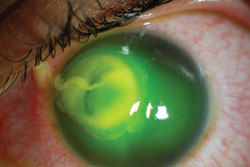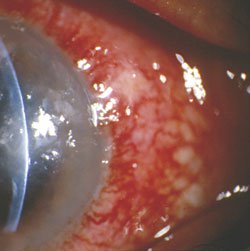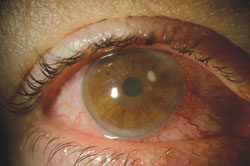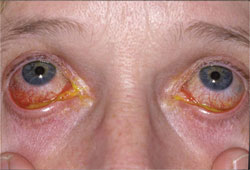Clinicians choose advanced anti-infectives when faced with evolving pathogens
 Andrew S. Gurwood |
The landscape of ocular infection is changing, practitioners report, and the changes are not consistent from practice to practice.
“Bacterial conjunctivitis may result from a proliferation of gram-negative or gram-positive organisms,” Andrew S. Gurwood, OD, FAAO, a professor of clinical sciences and an attending optometric physician at the Eye Institute of the Pennsylvania College of Optometry, Philadelphia, told Primary Care Optometry News.
“In most instances, because topical later-generation quinolone antibiotics serve as broad-spectrum agents, they are considered by many to be the topical antibiotic of first choice,” he said. “Given their reputation for eradicating superficial ocular infections, treatment of bacterial conjunctivitis is frequently empirical, without culturing.
 Some practitioners are seeing a shift away from common organisms such as the gram-negative Pseudomonas. Images: Muckley ED |
“Because we understand that gram-positive staph or strep organisms make up the predominant populations of the eye’s natural adnexal and conjunctival flora, in cases of bacterial conjunctivitis, blepharitis or keratoconjunctivitis, those organisms are presumed to be the source first,” Dr. Gurwood continued. “In cases of hyper-acute bacterial conjunctivitis, one of the usual suspects is Neisseria gonorrhoeae, which is gram-negative; however, the gram-positive Staphylococcus aureus, Staphylococcus epidermidis and Streptococcus organisms, which are among the most predominant organisms normally populating the epidermis of the eyelid, are the more common instigators.”
 Elizabeth D. Muckley |
Elizabeth D. Muckley, OD, FAAO, director of Optometric Services at Northeast Ohio Eye Surgeons in Kent, Ohio, speculated that gram-positive infections are becoming more frequent than gram-negative because of the aging population and more patients wearing contacts lenses and make-up. “Patients with active lifestyles also have more oil on their lids from their complexions due to being in the sun, which can aggravate rosacea,” she told PCON.
Most of the conjunctivitis Dr. Muckley observes is either strep or staph. She finds that most bacterial infections are staph and related to the eyelids.
“I see a good amount of blepharitis- and rosacea-associated conjunctivitis,” she said. “But I have not seen much methicillin-resistant Staphylococcus aureus (MRSA).”
With endophthalmitis, Streptococcus is encountered as well, she added.
For more central and rapid onset of a contact lens-related infection, Dr. Muckley often suspects Pseudomonas.
However, a more marginal ulceration is typically considered staph.
 Mycobacterium corneal ulcer. Immunocompromised patients can experience mycobacterial infections. |
Refractive surgery-related infection “is rare, but we always have to remember the mycobacteria in atypical infections,” she said.
 Joseph P. Shovlin |
In an immunocompromised patient, infections can range from mycobacterial to herpetic to Candida, Dr. Muckley added.
Over the past few years, Joseph P. Shovlin, OD, FAAO, senior optometrist at Northeastern Eye Institute in Scranton, Pa., and PCON Editorial Board member, has seen some shift away from common organisms such as Pseudomonas to a few Nocardia bacterial infections. Occasional Serratia infection has also cropped up in gas-permeable lens wearers, he said in an interview.
Among disposable lens wearers, infections tend to be gram-positive organisms (usually staph), whereas, in the past, Pseudomonas “would trump everything,” Dr. Shovlin added. “However, there are some emerging concerns about MRSA.” In contact lens wearers, “the No. 1 bug is certainly now staph, with a fair number being MRSA.”
 Randall K. Thomas |
But for immunocompromised patents, nonbacterial infections (mainly Mycosporidia and Rhinosporidium) are a much greater concern, he added.
Private practitioner and PCON Editorial Board member Randall K. Thomas, OD, MPH, FAAO, said when a patient presents with a contact lens-related infection, clinicians may suspect a gram-positive Staphylococcus, “but we are also concerned with the possibility of a gram-negative Pseudomonas aeruginosa,” he told PCON. “Additionally, bacterial conjunctivitis is rarely ever cultured, so we go on the premise that it is mostly staph: S. aureus or Staphylococcus epidermidis.”
When to culture
The three primary conditions for which Dr. Thomas cultures are a postsurgical infection, a child with a fairly severe infection and a significant corneal infection. Obtaining a culture is usually triggered by considerable pain and eyelid involvement.
Dr. Shovlin said that since the emergence of later-generation, broad-spectrum antimicrobials – the fluoroquinolones – he tends to treat more infections empirically without cultures. “But there’s hardly a week in which we don’t culture something,” he said.
 Staphylococcal corneal ulcer. Many clinicians consider Staphylococcus to be the No. 1 pathogen. |
His criteria for culturing include an infection that impacts the visual axis, a history of vegetative trauma or hospitalization, or a patient who is not responding to seemingly appropriate therapy. Scleral extension, 50% thinning of the cornea or an infiltrate about the same depth is also likely criteria for culturing, he said.
Blood and chocolate agar plates will capture most worrisome pathogens, according to Dr. Shovlin, especially in the contact lens population.
“Blood will even grow fungus at the right temperature, but we still plate on Sabouraud’s if mold or yeast are suspected organisms,” he said. “Several polymerase chain reaction probes are now available for clinical bacterium and nonbacterium detection.”
Dr. Muckley always cultures contact-lens wearers who present with a large, central ulcer and rapid decrease in vision.
“These are sight-threatening cases,” she said. “You need to determine if it is bacteria. With the recent increase in the incidence of Fusarium and Acanthamoeba, you have to make sure you are not dealing with an atypical organism.”
In contrast, more peripheral and extremely small ulcers are usually not cultured in her practice, she said.
Dr. Gurwood cultures bacterial conjunctivitis infections only when they do not resolve with standard topical treatment, when they involve the cornea (concurrent microbial keratitis) or if the history or appearance suggests a sexually transmitted disease.
“This would require oral therapy (such as azithromycin for Chlamydia) or an injection of antibiotic (ceftriaxone or ceftazidime for gonorrhea) as part of the treatment regimen,” he said.
Treatment choices
Dr. Thomas said that first-line therapy typically consists of an advanced-generation fluoroquinolone, “particularly the newer Besivance (besifloxacin, Bausch & Lomb), which is a chlorofluoroquinolone.”
The ophthalmic suspension eye drop can also be combined at bedtime with an ointment such as generic polysporin, he said.
 This patient has a classic presentation of mucopurulent discharge that is pathognomonic of an ocular surface bacterial infection. Note that a red eye with no discharge indicates an inflammatory conjunctivitis, not one of infectious origin. Image: Thomas RK |
“If the infection is caught early and treated aggressively, the success rate should be close to 100%,” Dr. Thomas said.
For children, an economical, generic Polytrim (polymyxin B-trimethoprim, Allergan) is available. “This is a good, broad-spectrum antibiotic that is highly effective for bacterial conjunctivitis,” Dr. Thomas said.
In general, for all these conditions, the first-line therapy “does the job,” he said.
Dr. Thomas noted that eye care professionals tend to overprescribe antibiotics when there are no clinical indications. “The epidemiology of the acute red eye is inflammatory, not infectious, 95% of the time,” he said.
Dr. Shovlin chooses dual agents that provide both good gram-negative and good gram-positive coverage for potentially sight-threatening infections that can cause significant corneal morbidity, for example, a fortified aminoglycoside such as tobramycin with vancomycin or an earlier-generation cephalosporin. For infections that are not quite as potentially sight-threatening, he often prescribes a single-agent therapy consisting of a newer-generation fluoroquinolone such as Besivance, Zymaxid (gatifloxacin 0.5%, Allergan) or Moxeza (moxifloxacin 0.5%, Allergan).
Dr. Shovlin’s usual choice for second-line therapy is vancomycin for gram-positive organisms and amikacin for gram-negative organisms. “But, in general, first-line therapy achieves about a 93% to 95% cure rate, as reported in the literature,” he said.
Dr. Muckley also prescribes the later-generation fluoroquinolones – Moxeza, Zymaxid and Besivance – as first-line therapy, “with Besivance possibly being slightly more effective for MRSA,” she said.
For aggressive ulcers, fluoroquinolones are often combined with fortified antibiotics. “But first-line therapies are usually very successful,” she agreed.
Second-line therapy for conjunctivitis might be AzaSite (azithromycin, Inspire Pharmaceuticals), “which is great, especially for children or patients who have a hard time getting drops in, because it is twice a day to start, then once a day,” Dr. Muckley said. “In just a few days, it is like a Z-Pak for the eye.”
Like the other clinicians, Dr. Gurwood’s first-line of therapy is the later-generation fluoroquinolones, which he said successfully treat most superficial ocular infections.
“The literature demonstrates similar efficacy profiles for the agents in this class with no clearly superior agent,” he said.
Still, there are anecdotal reports in the literature that favor one medicine over another because “it is more comfortable to the patient, which, in turn, would obviously encourage compliance,” he added. “But these reports are conflicting.”
Regardless, Dr. Gurwood said that later-generation fluoroquinolone therapy “almost never fails. If it fails, you have to either question your diagnosis or culture the infection to understand why.”
Once the offending microorganism is identified, “use the antibiotic that defeated the organism in the culture and sensitivity test,” he said.
A fortified preparation may be required, Dr. Gurwood added. “Here, the culture and sensitivity test will provide a susceptibility profile,” he said. “The doctor can instruct the pharmacy to create the recommended medication. Examples include fortified gentamicin, tobramycin, amikacin and cephazolin.”
Dr. Gurwood said clinicians must continually consider new agents and new approaches to defeat these evolving microorganisms. – Bob Kronemyer

- Andrew S. Gurwood, OD, FAAO, can be reached at the Pennsylvania College of Optometry, 1200 West Godfrey Ave., Philadelphia, PA 19141; (215) 276-6134; agurwood@salus.edu.
- Elizabeth D. Muckley, OD, FAAO, is director of Optometric Services at Northeast Ohio Eye Surgeons. She can be reached at 2013 State Rt. 59, Kent, OH 44240; (330) 678-0201; dredm1@aol.com.
- Joseph P. Shovlin, OD, FAAO, is a member of the PCON Editorial Board. He can be reached at Northeastern Eye Institute, 200 Mifflin Ave., Scranton, PA 18503; (570) 342-3145; jpshovlin@gmail.com.
- Randall K. Thomas, OD, MPH, FAAO, is a member of the PCON Editorial Board. He can be reached at 6017 Havencrest Ct., Concord, NC 28027; (704) 792-6021; thomasepec@carolina.rr.com.
- Disclosures: Dr. Gurwood has no direct financial interest in any products mentioned in this article, nor is he a paid consultant for any companies mentioned. Dr. Muckley has no direct financial interest in any products mentioned in this article, nor is she a paid consultant for any companies mentioned. Dr. Shovlin is a paid advisor for Bausch + Lomb. Dr. Thomas is a consultant to Bausch + Lomb.
